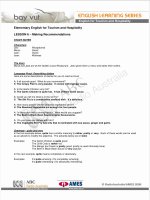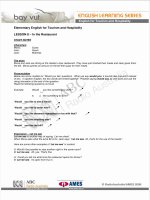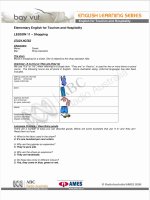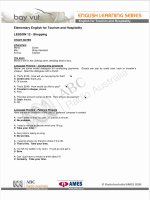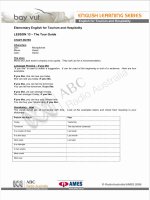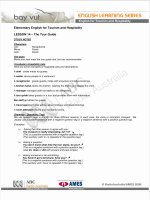English for sci and tech supp
Bạn đang xem bản rút gọn của tài liệu. Xem và tải ngay bản đầy đủ của tài liệu tại đây (408.41 KB, 93 trang )
SUPPLEMENTAL MATERIAL
English for
Science &
Technology
PAI H. CHOU
Foreword
on such topics. This book is for those who don’t have the time
to study those books but need a quick check-list to catch most
of the common issues.
Grammar is largely objective, but style is more subjective and
potentially debatable. I ask my own students to follow the
style guidelines that I either have learned from classic books
or have developed on my own. I think they are pretty good,
but if you know a better way to express something, feel free to
do so.
This book started out as a web page that I put together for my
own graduate students in Computer Engineering and Electrical Engineering. I did not want to keep repeating myself over
the same kinds of issues I saw when editing papers or theses
written by my students. So, I put together a quick bulleted list
of common mistakes I saw, and I asked them to read my web
page and fix those problems before I start editing their work.
This turned out to be very useful that I decided to format it as
an electronic book. It forces me to double-check what I wrote
and add what might be missing.
Another aspect rarely covered by conventional books is the
use of collaborative and formatting tools. More specifically, I
ask my students to write their papers in LaTeX for several reasons. It formats the paper in a professional look, especially
when it comes to math, whereas most word processors look
more amateurish. Bibliography support is also indispensable.
LaTeX also works well with a version control system such as
SVN (Subversion), CVS (Concurrent Versioning System), or
GIT. This becomes especially useful when you work on the
same paper with multiple students or other colleagues. Of
course, the tool part is entirely optional.
In this book, I give correct and incorrect examples. Incorrect
ones are preceded by an asterisk (*).
This book covers common issues in grammar, style, and tools,
but it is by no means complete or comprehensive. If you really
want to be a good writer, I trust that you will take your time to
learn from much better sources, including many classic books
i
C HAPTER 1
Practice
Practice makes perfect. The best way to
improve your writing is to develop a
habit of keeping a daily journal.
Keep a Daily Journal
The best way to practice writing is to develop the habit of writing a daily journal, for ten minutes a day. That is, just keep
typing sentences non-stop into a computer. It really doesn’t
matter what you write, as long as you just do a “brain dump.”
If you don’t know what to write, just type “I don’t know what
to write.”
Thoughts are not concrete until you put them into words. So,
this exercise helps you turn thoughts into a more concrete
form that you can then manipulate, organize, and reason with.
You might want to brainstorm from time to time, too, but you
should do your daily journal anyway. You will probably never
look at your journals ever again, but it is not a bad idea to
keep them anyway.
Read Broadly
Another way to improve your writing is to read anything that
interests you and read broadly. You will get exposed to different writing styles. Although some are definitely good sources
of style to follow, not all are, but you read them anyway, because you are likely to learn new ways to express a given idea
in simpler terms or with accessible analogies.
3
C HAPTER 2
Grammar
Know your grammar. Buy a book on
grammar and study it if you are not sure.
This chapter covers the common mistakes seen in not only student writing but
in published papers as well.
S ECTION 1
Singular vs. Plural
aircraft, faculty, deer, sheep, moose, fish, salmon, trout,
shrimp, species
In the case of fish, you could actually have the -s form but that
would refer to multiple species.
“ LESS ” VS . “ FEWER ”
“less” is for mass nouns, while “fewer” is for count nouns.
K NOW YOUR MASS NOUNS VS . COUNT NOUNS .
“ EACH ”, “ EVERY ”, “ ANY ”
A mass noun is one that cannot be counted (and therefore
cannot have a plural form). Examples include
These words should modify singular nouns, not plurals.
equipment, hardware, software, middleware ,
information, knowledge, paperwork, research, furniture
A count noun is one that can have a plural form. . Examples
include
It is a mistake to say *“every computers” (plural). It should be
singular.
It is more common to see “any” used with plural words. It may
be almost acceptable in some cases, but strictly speaking, you
really should use the singular form.
approach(es), impact(s), clothes
Some count nouns do not take s in their plural form but may
appear identical in both singular and plural forms. For instance
5
S ECTION 2
Run-on Sentences
verbs, not conjunctions, and therefore cannot connect two
complete sentences!
For example, it is correct to say
I was hungry, so I ate my apple.
but it is incorrect to say
*I was hungry, thus I ate my apple.
A run-on sentence is one where several complete sentences
are simply stuck together either without punctuation or with a
comma. In English, run-on sentences is considered a serious
offense, even though in other languages it is common practice
(e.g., Chinese) due to lack of strict grammar rules.
Run-on sentences are further divided into several types. Some
can be fixed easily by replacing a comma (,) with a period (.)
or a semicolon (;). Others require inserting words such as
“that”, “which”, “where”, to convert one of the sentences into a
clause that modifies the other sentence.
*I was hungry, therefore I ate my apple
Both are run-on sentences. You can fix these sentences by
• replacing the comma with a semicolon,
• with a period and starting a new sentence, or
• inserting an “and” after the comma.
“ THUS ”, “ THEREFORE ” VS . “ SO ”
The words “thus” and “therefore” are similar to “so” in meaning but they are not interchangeable. The word “so” can be
used [as a conjunction] to connect two complete sentences
as cause and effect. However, “thus” and “therefore” are ad6
S ECTION 3
Articles
“ A ”/ “ AN ” VS . “ ANY ” VS . “ ONE ”
They are synonymous, but “one” emphasizes the fact there is
one.
A N ARTICLE IS REQUIRED IN FRONT OF A SINGULAR
COUNT NOUN
This is possibly the most common mistake of some Asian nonnative speakers of English.
An article is a grammatical word that indicates whether a
noun refers to something general or specific. That is,
“the” is called a definite article, which means the noun that
follows refers to specific ones that either the speaker has in
mind or to certain ones in relation to other nouns being mentioned.
“a”/“an” are called indefinite articles, which means the
noun that follows is a generic one. One can almost think of it
as “any” or “one”.
D EFINITE VS . I NDEFINITE A RTICLE
They mean different things, even though the difference may
be quite subtle.
[to do]
Exception: any, every, each ...
A MASS NOUN CAN TAKE A DEFINITE ARTICLE OR NO
ARTICLE
Just because a noun is not countable does not mean you cannot refer to it. For example
I drink water.
I drink the water.
The former refers to the fact that I drink water as one of the
things that I do, without specifying specific source; the latter
refers to specific kind or source of water.
7
T HE CHOICE OF “ A ” VS . “ AN ” IS DETERMINED BY PRONUNCIATION , NOT SPELLING .
As a specific example, it is “a” university, not “an” university,
because the “u” in university is pronounced like /yu/, even
though the letter “u” is often considered one of the five vowels.
Some speakers may have trouble hearing the /y/ sound. It is
actually a consonant, even though it sounds very much like
the vowel. Specifically, it is
a year
an ear
The word “year” starts with the /y/ consonant that requires
you to tense up the part behind your upper teeth initially. On
the other hand, the word “ear” does not have the /y/ consonant but simply has the tongue and mouth in the rather unstressed, neutral position as the letter E (no initial tensing behind the teeth).
C ERTAIN WORDS CAN BE PLURAL EVEN IF THEY DON ’ T
APPEAR PLURAL .
Example: faculty, deer, cattle (actually it is a plural noun).
8
S ECTION 4
Compound Modifiers
The reason for hyphenation is to help parsing. Without hyphenation, one could actually group the nouns differently and
end up with a different parse syntactically, even though semantically one may be able to rule out another parse. For instance
low power consumption
low energy efficiency
A modifier is a word, compound word, or a phrase that serves
as an adjective to a noun. A compound modifier is a modifier
that consists of a compound word.
H YPHENATE A COMPOUND WORD IF YOU WANT TO USE
IT AS AN ADJECTIVE ON ANOTHER NOUN .
For example
They are not hyphenated, because both “power consumption”
and “energy efficiency” are compound words, and you want
“low” to modify the compound words. This is in contrast to
“low-power radio”, where “low-power” modifies “radio.” However, if hypothetically speaking “power radio” could be a compound word, then “low power radio” would be parsed the
same way as “low power consumption.”
D O NOT HYPHENATE AN ADVERB - ADJECTIVE SEQUENCE TO TURN IT INTO AN ADJECTIVE .
For example, the following are incorrect:
a news-worthy article
a host-assisted parser
*It is an extremely-hot day.
a one-week vacation
*That is an incredibly-tasty cake.
a two-year-old boy
a low-power radio
high-quality furniture
No hyphens are needed because the adverb is already playing
its normal role of modifying the adjective.
9
D O NOT HYPHENATE L ATIN COMPOUNDS SUCH AS “ AD
HOC ”
For example,
*ad-hoc network
This is incorrect because ad hoc is a multi-word adjective already, not a compound English word. There is no parsing ambiguity.
10
S ECTION 5
Transitive vs. Intransitive
Verbs
You need to maintain a GPA of 4.0.
You need to remain in this lane.
You need to keep a GPA of 4.0.
You need to stay in this lane.
The following sentences are incorrect:
*You need to keep in this lane.
*You need to remain a good student with a 4.0 GPA.
A transitive verb is one that takes a direct object, plus possibly an indirect object; an intransitive verb is one that either
does not take an object, except connected by a preposition.
*You need to stay this house. (missing “in”)
Example of transitive verbs include eat, drink, see, take, send,
consume, ...
Examples of intransitive verbs include yawn, sleep, tremble,
hover, float, ...
Some verbs come in both forms. For example, move, spin,
turn, flip, ...
T RANSITIVE AND INTRANSITIVE VERBS ARE NOT INTERCHANGEABLE , EVEN IF THEY ARE SYNONYMS .
transitive: maintain, keep
intransitive: remain, stay (except for rare cases)
The following sentences are correct:
11
S ECTION 6
A SUBORDINATE SENTENCE IS NOT A COMPLETE SEN-
Conjunctions
TENCE .
A subordinate sentence is a sentence after a subordinate
conjunction. For example,
After we ate dinner last night
Once you hear this song
Whenever I need to take a break
Conjunctions are grammatical words that connect words or
sentences jointly. They are further divided into several types.
A coordinating conjunction connects words of the same
parts of speech, clauses, or complete sentences together. They
include
Even though “we ate dinner last night”, “you hear this song”, and
“I need to take a break” are all complete sentences on their own,
these subordinate sentences are no longer complete sentences, but
they need to be connected to a main sentence. This is a
grammatical requirement, not a style issue.
D O NOT START A SENTENCE WITH A COORDINATING
-- AT LEAST NOT “ AND ”, “ OR ”, “ BUT ”
• and, or, but
CONJUNCTION
• for, yet, so
The reason is that “and”, “or”, and “but” are supposed to connect
two complete sentences together, one on each side. If you start a
sentence with the conjunction, then you are connecting an empty
sentence with another sentence. An empty sentence cannot really
be considered a sentence, and this is considered bad style. In
practice, the writer actually does not mean an empty sentence but
refers to the point that was made in the preceding sentence(s).
• nor
A subordinate conjunction marks a word, a clause, or a
sentences as a subordinate in relation to the other.
• after, although, as, because, before, even if, even though, if, in
order that, once, provided that, rather than, since, so that, than,
that, though, unless, until, when, whenever, where, whereas,
wherever, whether, while, why
12
A SUBORDINATE SENTENCE , SUBORDINATE CLAUSE ,
OR SUBORDINATE WORD SHOULD NOT BE JOINED
WITH THE MAIN SENTENCE BY A COORDINATING CONJUNCTION
The most common mistake is the “although...but” combination.
*Although I have not read the book, but I heard a lot of
good things about it.
This is not correct for several reasons. “Although” marks “I
have not read the book” as a subordinate sentence, but it is
subordinate to “but I heard a lot of good things about it” -which can be viewed as a sentence that starts with a coordinating conjunction, a bad style.
Another way to view this is that a coordinating conjunction
should join two units of the same type, even if the purpose is
not to form a larger unit of the same type. Because “I heard a
lot of good things about it” is a complete sentence, you should
not join it with “Although I have not read the book” because it
is not a complete sentence. In other words, the two parts before and after “but” are uncoordinated.
13
S ECTION 7
To
I went to the kitchen.
The store is two blocks to the south.
You should look to your left before making a left turn.
W HEN EXPRESSING AN INTENT WITH A VERB , THE INFINITIVE “ TO ” IS USED .
For example, the following “to”s are all infinitive marker (i.e.,
#2) that express intent or purpose.
The word “to” serves multiple parts of speech:
I want to eat an apple.
1.
He paid extra to support organic farmers.
preposition (“to the left”) -- precedes a noun;
I attended the seminar to learn about computers.
2.
infinitive marker (“to eat”) -- precedes a verb
3.
adverb (“pull the door to behind me”) -- modifies a verb
W HEN RELATING TO AN ACTION THAT IS NOT AN IN-
The first two are used frequently and sometimes confused
when a verb is involved.
TENT , USE THE GERUND ( I . E ., - ING ) FORM OF THE
W HEN EXPRESSING DIRECTION OF MOTION OR LOCA-
For instance
VERB RATHER THAN THE INFINITIVE .
TION MARKED BY A NOUN , THE PREPOSITION “ TO ” IS
USED .
I look forward to seeing you tomorrow.
They take a greedy approach to solving this problem.
For example
In the first case, the “to” goes with “look” (e.g., “look to your
left”) and is a preposition rather than an infinitive. Therefore,
it needs a noun form of “see” -- namely “seeing.”
14
In the second case, the “to” goes with “approach” and marks
the “destination.” Therefore, it should also be the noun form
(“seeing”), rather than the infinitive (* “to see”).
To make or help someone do something, do not add “to” before the verb.
15
C HAPTER 3
Semantics
abstract vs. concrete words
literal vs. figurative uses
S ECTION 1
Abstract vs. Concrete
words
You can't "show" or "display" information, either; but you can
show or display a graph or a chart that conveys the information.
Although it is understandable when you say you send or transmit information rather than data, it is imprecise and can be
viewed as sloppy and confusing because it cross abstraction
layers.
A BSTRACT THINGS CANNOT BE MANIPULATED . Y OU
CAN MANIPULATE ONLY ITS CONCRETE REPRESENTATION .
Examples of abstract concepts include
information
knowledge
Examples of concrete things include
data, figure, table, chart, plot, diagram, graph
You can't "send" or "transmit" information; you can transmit
"data", which encodes information.
17
S ECTION 2
Literal vs. Figurative Use
It would be rare if the exam is literally big -- i.e., given on an
extra large sheet of paper or is extra heavy!
In technical writing you should use other verbs that express
the magnitude or extent, rather than the physical size, such as
"main disadvantage" or "major disadvantage."
The literal meaning of a word is its original meaning; the
figurative meaning of a word is derived based on an analogy
or a metaphor.
For instance, the word “big” means literally “of large physical
size.” such as a
big car, big building, big fruit, big TV,
Figuratively, it is used for modifying abstract nouns such as
a big disadvantage, big corruption, big exam
For instance, “a big exam” usually means one that tests many
subjects from a course, can take several hours to complete, or
requires a lot of preparation. Therefore, it is used figuratively.
18
S ECTION 3
One very common mistake is to spell it as two words, “can
not” when one means “unable to.”
Cannot vs. Can Not
Consider the following pair
He cannot breathe for two minutes
He can not breathe for two minutes
The first means he is unable to breathe for two minutes; the
second means he can hold his breath for two minutes.
Normally, “cannot” as in “unable to” is spelled as one word,
not two.
Because “can not” is often misunderstood, it is best to paraphrase the sentence by possibly using alternative words and
constructs whenever possible.
“cannot” means “unable to”
“can not” means “able not to”
This is rather strange, because of all the auxiliaries that can
have the negated form, “cannot” is the the only one that is
spelled as one word, whereas all the other ones are spelled as
two words! That is,
AUXILIARY
NEG. CONTRACTION
FULL FORM
can
can’t
cannot
should
shouldn’t
should not
must
mustn’t
must not
do
don’t
do not
19
S ECTION 4
Only
The word “only” can go in many places in a sentence, because
it can be either an adjective or an adverb.
Normally, “only” goes in front of the word or phrase it is modifying. In fact, it should go immediately before what it is modifying. Consider the following sentences
I only ate an apple. (all I did was to eat an apple)
I ate only an apple. (all I ate was an apple)
These two sentences mean different things! In the first sentence, “only” modifies “ate”, an action. This means among actions that I could have done, all I did was to eat an apple (and
did not do anything else). In the second sentence, “only”
modifies “an apple”, which means among all the things I could
have eaten, all I ate was an apple (and I ate nothing else).
20
S ECTION 5
Should vs. Supposed to
“should” and “ought to” both mean the same. Actually, “ought
to” is potentially stronger in emphasizing the judgmental aspect.
U SE “ SUPPOSED TO ” WHEN YOU MEAN PREDICTION OR
EXPECTATION WITHOUT NECESSARILY MAKING THE
RIGHT OR WRONG JUDGMENT .
You could also use “should” and even “ought to” in informal
speech when you mean “supposed to”, but it makes your writing sound less stringent.
“Should” and “[is] supposed to” have similar meanings. They
can mean
For example,
• is obligated to (i.e., it is the right thing to do...)
Inlining is supposed to reduce runtime overhead at the
• is assumed to (i.e., based on normal prediction)
*Inlining should increase runtime overhead at the cost
Note that the former is a matter of “right or wrong” and is
more judgmental, while the latter is based on pattern, statistics, equations, or algorithms, without necessarily making the
right or wrong judgment.
of code size.
Not all languages use different words or expressions to distinguish between these two meanings, but in English, you should
at least distinguish them, especially in technical writing.
cost of code size.
The second sentence is understandable but can also be misinterpreted in the judgmental sense. Therefore, you should
avoid the second one unless you have very compelling reasons
for doing so.
U SE “ SHOULD ” OR “ OUGHT TO ” WHEN YOU MEAN OBLIGATION ( I . E ., IT IS THE “ RIGHT THING ” TO DO SO )
21
S ECTION 6
Comparative and Superlative
A comparative of an adjective is one that expresses “more
of” the plain adjective itself (e.g., “better” vs. “good”). One
that is “less of” is also a comparative (e.g., “worse” vs. “good”).
A superlative is one that expresses “the most of” the adjective (e.g., “best” vs. “good”).
An absolute adjective is one that expresses an extreme condition. Examples include “unique”, “essential”, “indispensable”, “full”, “empty”, “complete”.
A BSOLUTE ADJECTIVES SUCH AS “ UNIQUE ”, “ ESSENTIAL ”, AND “ INDISPENSABLE ” SHOULD NOT BE USED
IN THEIR COMPARATIVE OR SUPERLATIVE FORM DUE
TO SEMANTIC CONTRADICTIONS .
For instance, the following are not quite correct:
*That is a more unique stamp than this one.
*That is the most unique stamp I have ever seen.
The word “unique” means “one of a kind.” The first sentence is
incorrect because if something is “more unique” but not “the most
unique,” then it is not one of a kind in the first place and is
therefore not unique (and therefore cannot be more unique)! To
fix this sentence, you should pick another adjective such as “rare”,
which is not an absolute adjective.
The second sentence is incorrect because something cannot be
“most unique” if there cannot be anything less unique to set the
context. In other words, the “most unique” would just be “unique”
in the first place. In other words, “most unique” is just “unique”
by definition.
Similarly, one frequent mistake is to say
*This is the most essential function in the system.
The contradiction here is that if anything is “less essential”
then it is not essential in the first place. Therefore, most essential is just essential.
One may argue that comparatives and superlatives of absolute
adjectives are still understandable in informal speech, but
those adjectives are used as figurative speech rather than their
literal sense. You should use figurative speech sparingly in
technical writing.
22
C HAPTER 4
Style
Style is about making the writing precise,
concise, easy to read, elegant. It is not
about grammar -- it is about elegance.
S ECTION 1
Style Guides
Unlike grammar, style guides are not hard rules, but they are
more like (highly) recommended practices to make your writing more elegant. Good style means your writing is concise,
precise, and easy to read. Readers generally appreciate elegant writing, just as people in general appreciate looking at
beautiful things. Moreover, you want to have a point to make
and support your point with persuasive reasoning or evidence.
Style guides have been published by many. Here are some
classic ones that are worth a look.
• Sheridan Baker, The Practical Stylist.
• William Strunk, Jr., The Elements of Style. available online,
at />
24

